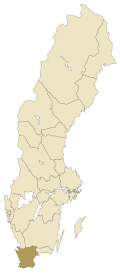Portal:Denmark
Welcome to the Denmark Portal! | ||||

|

|

| |
Denmark is the smallest and southernmost of the Nordic countries. Unified in the 10th century, it is also the oldest. Located north of its only land neighbour, Germany, south-west of Sweden, and south of Norway, it is located in northern Europe. From a cultural point of view, Denmark belongs to the family of Scandinavian countries although it is not located on the Scandinavian Peninsula. The national capital is Copenhagen.
Denmark borders both the Baltic and the North Sea. The country consists of a large peninsula, Jutland, which borders Schleswig-Holstein; many islands, most notably Zealand, Funen, Vendsyssel-Thy, Lolland, and Bornholm; and hundreds of minor islands often referred to as the Danish Archipelago. Denmark has historically controlled the approach to the Baltic Sea, and those waters are also known as the Danish straits.
Denmark has been a constitutional monarchy since 1849 and is a parliamentary democracy. It became a member of the European Economic Community (now the European Union) in 1973. The Kingdom of Denmark also encompasses two off-shore territories, Greenland and the Faroe Islands, both of which enjoy wide-ranging home rule. The Danish monarchy is the oldest existing monarchy in Europe, and the national flag is the oldest state flag in continuous use.
Selected biography

Hans Christian Ørsted (August 14, 1777 – March 9, 1851) was a Danish physicist and chemist, influenced by the thinking of Immanuel Kant. He is best known for discovering the relationship between electricity and magnetism known as electromagnetism.
From 1806, Ørsted was a professor at the University of Copenhagen. He was instrumental in the founding of the university's Faculty of Science shortly before his death. In the 1960's the main building complex of the university's new science campus was named in his honor.
Ørsted was the driving force behind the founding of the Technical University of Denmark in 1829 and served as its first director. The present-day department of applied electronics is named Ørsted·DTU in his honor.
Recently selected: Bjørn Lomborg - Tycho Brahe - Ludvig Holberg
Selected picture
Selected article
Scanian was previously classified as a regional language by SIL International, but before the latest update, the Swedish representative to ISO/TC-37, the technical committee overseeing ISO 639, required that Scanian be removed from the ISO/DIS 639-3, the draft just prior to the final draft FDIS, or a positive vote from Sweden would not be forthcoming. The prior identifier ISO 639-3:scy, as used in the Ethnologue 15th edition, is reserved for Scanian, and may become active again if a request is submitted to have it reinstated during the annual review process. Within the previous SIL International classification of Scanian were the dialects in the province of Scania, some of the southern dialects of Halland (halländska in Swedish), the dialects of Blekinge (blekingska in Swedish) and the dialects of the Danish island of Bornholm (bornholmsk in Danish).
Selected place
The museum buildings are organized into a small village of chiefly half-timbered structures originally erected between 1550 and the late 1800s in various parts of the country and later moved to Aarhus during the 1900s. There are several groceries, diners and workshops spread throughout the village with museum staff working in the roles of typical village figures i.e. merchant, blacksmith etc. adding to the illusion of a "living" village.
Categories
Denmark topics
Things you can do
- Expand stubs:
Geography stubs · People stubs · Denmark stubs in general
Help us extend these stubs and make them real articles!
- Categorize:
Help us categorize Denmark-related articles
- WikiProjects:
Have a look at WikiProject Denmark, WikiProject Faroe Islands, WikiProject Greenland and WikiProject Norse history and culture
- Noticeboard:
Have a look at the Danish Wikipedians' notice board
- Geotag:
Find coordinates for these locations and tag them: articles missing geocoordinate data
Related portals
Northern Europe
Other countries
Associated WikiMedia
The following Wikimedia Foundation sister projects provide more on this subject:
-
Commons
Free media repository -
Wikibooks
Free textbooks and manuals -
Wikidata
Free knowledge base -
Wikinews
Free-content news -
Wikiquote
Collection of quotations -
Wikisource
Free-content library -
Wikispecies
Directory of species -
Wikiversity
Free learning tools -
Wikivoyage
Free travel guide -
Wiktionary
Dictionary and thesaurus














